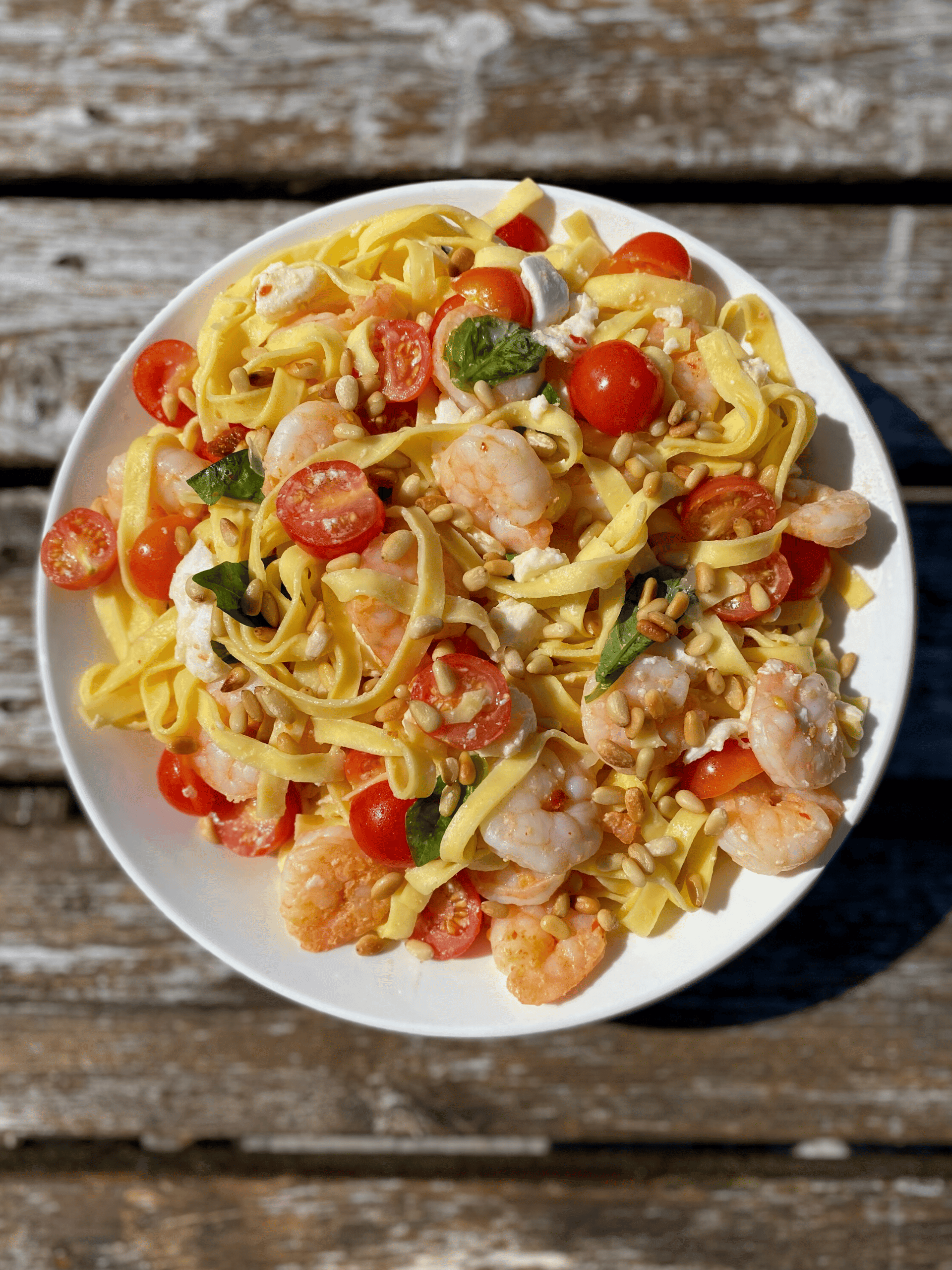Sometimes knowing what to do just isn’t enough.
I know I don’t need another biscuit, but it’s there and it looks good.
What is that feeling that takes over and reduces our ability to make the optimal choice at that moment?
Relying on will power can only take us so far. How can we build better self regulation (ability to understand and manage our behaviour and reactions to feelings and things happening around us) when it comes to our eating habits?
It has been strongly recognized that without behavior change, a ‘diet’ isn’t effective.
Is mindful eating the answer?
Before discussing mindful eating let’s first define mindfulness.
“Mindfulness means paying attention in a particular way; On purpose, in the present moment non-judgmentally.” – Jon Kabat-Zinn
It means focussing awareness (attention) on the present moment.
How am I feeling?
How am I thinking?
What am I doing?
How is my breathing?
Mindfulness can help us:
- Become less reactive & make better choices
- Create space between trigger & response
- Reduce stress levels
- Increase self regulation
So how does this relate to eating?
The Food Environment
Most of our eating is done on autopilot and mindless eating in our society is the norm. Occasions are celebrated through food, we use food to comfort or distract us & snacking between meals can often be down to boredom or out of habit. Our environment doesn’t particularly favour optimal food choices either. Shops are layed out to play on consumer psychology surrounding us with food advertisements, making us feel like we need to buy that mouth-watering product on display. We’re overwhelmed by product choice. Share-size portions are cheaper which often push us to purchase a larger portion than intended. Many override hunger and satiety levels on a regular basis and never really pay much attention to or are not even aware of our true internal ques.
While it’s common to place pressure on ourselves to ‘just make better choices’, or ‘stop giving in’, It’s much more than just ‘self-control’ when it comes to improving food choices and health behaviours. However, improving our ability to be more mindful and build interoceptive awareness (awareness of inner body sensations), will also strengthen our ability to make decisions in line with our values and goals regardless of our external environment at any given time. This becomes particularly important and useful in times when we are inclined to forget or be less focused on our goal.
Factors Which Influence Food Choice
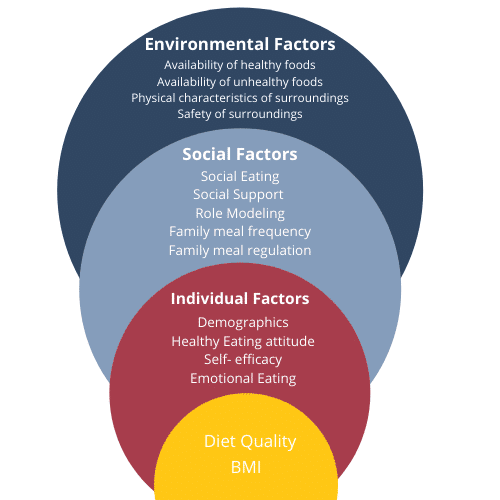
Meeting our needs effectively
Often, we use food or other coping strategies to satisfy emotional needs that are better met with other tools. For example we might reach for food when we’re feeling bored or tired. Developing an understanding of our myriad physiological and emotional needs, as well as how to meet them most effectively in ways that align with our values and goals, is important for sustained, committed action.
Having an ability to distinguish and label feelings isn’t a natural skill for everyone. It can be difficult for some to acknowledge the difference between hunger and true emotion. This lack of interoceptive awareness can desensitise hunger and satiety. Taking the time to recognise feelings and emotions as they change allows us to create solutions to the challenges we regularly face. This skill takes time to build and it is important that we continue to strengthen it, regularly checking in with these feelings and emotions.
Where to Start With Mindful Eating
Noticing triggers can be a useful place to start building alternative coping strategies for emotional hunger rather than food. Using food to comfort us is completely normal, however it can become problematic when using food to deal with emotions (positive or negative) is our only coping strategy. Especially when other strategies (tools) are a better fit for the job such as movement, catching up with friends, spending quality time with family, meditation, practising /learning a skill. While this might sound like a simple solution, it requires time, patience and consistent effort to explore and develop these skills. However the alternative is pushing away difficult emotions and not dealing with them, which can be harmful for long term mental and physical health.
Finding the trigger or source of the problem can help to create a solution to the challenges you find yourself regularly faced with. For example, it is common for an instant reaction to occur when a craving arises. However, if we are able to create a gap between the trigger and response, we can improve our decision making ability and self-regulation by responding to our true needs, rather than ignoring or pushing them away or dealing with them in less helpful ways. Within this gap, we can pause to ask ourselves how we are really feeling? Am I emotional? Am I lonely or bored? Has something happened that has triggered me to reach for this food?
Considering the source recognises that different triggers occur everyday. One day you may be feeling stressed, another day you’re feeling tired, angry or sad. By identifying which trigger it is, you can improve your ability to deal with it appropriately and choose the correct coping strategy.
Setting the right intentions…
A simple place to start:
When I_______, I feel _________. I need ________ so I will _______.
When I get home from work, I feel tired. I need to feel more relaxed and energised, so I will do 15 mins of yoga …/meditate/ read a book/go for a walk.
What if I struggle to identify my feelings/emotions?
Maybe you struggle to identify what you are truly feeling. Try using the emotions word wheel below to help you. The better we are able to label the specific emotions we are feeling, the better we can understand how to appropriately respond. It has been shown that putting a name to your emotions instantly releases their grip over you and can reduce physiological distress.
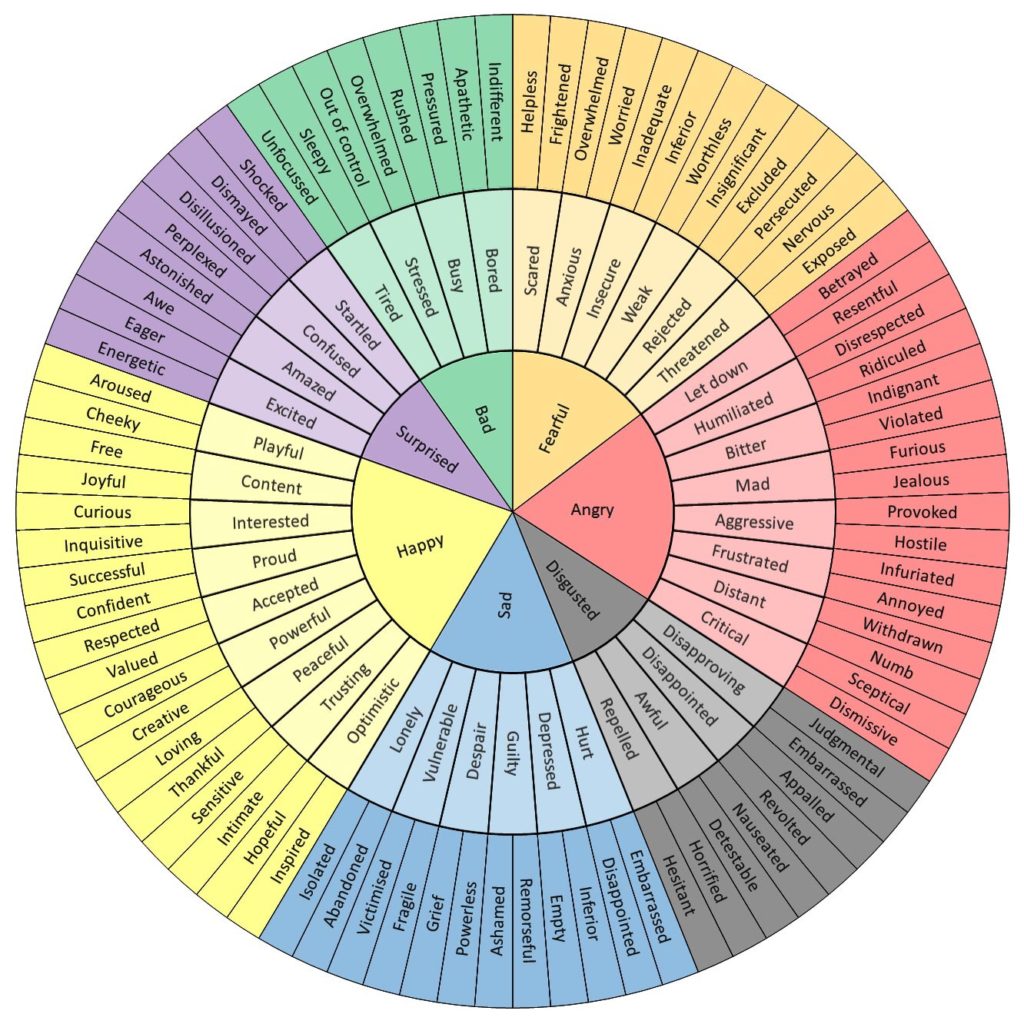
I feel ______ because__________.
After identifying what you are feeling, you can then look to figure out what led you to feeling this way. Creating the space between the trigger and response can then enable you to be aware of the decision you are making and empower you to decide how you want to react.
The next time you feel a trigger that is leading you to eat (in the absence of hunger) or even if an unhelpful thought arises, try this exercise:

Mindfulness based eating process
Mindfulness-based eating can transform problematic eating, help us achieve our goals and improve our health. It’s based on the idea that emotional eating disconnects us from our regulatory systems. Our ability to self regulate depends on our ability to self-observe. Increasing attention to your current experience may help you become more aware of your emotions. The more we can cultivate self observation, the further our ability to self-regulate is increased.
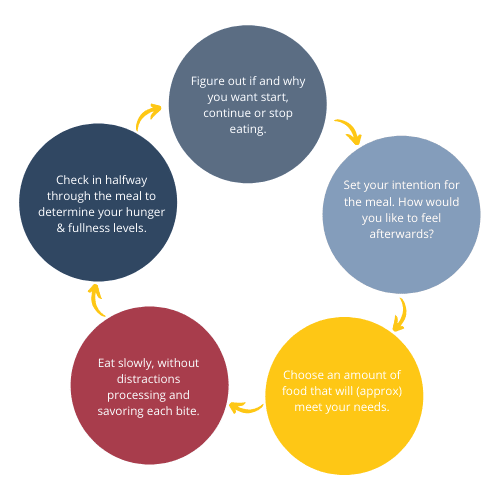
Mindful eating is flexible, there are no strict set of rules to follow. It’s tuning into hunger & satiety levels, really tasting your food, learning when you have had enough, choosing foods wisely and balancing both ‘inner’ and ‘outer’ wisdom.
The need for outer wisdom
The education component when it comes to nutrition & health can’t be ignored. Within daveynutrition we aim to find the balance between both inner and outer wisdom, which in turn aims to lead to autonomous health behaviours. Providing you with the knowledge to know what works and the ability to follow through with making optimal choices to support your health and nutrition goal.
The Hunger Awareness Scale
The hunger awareness scale can be a great place to start to become more aware of your physical hunger. Rate your sensations of hunger using the scale below. The goal is to be able to fine-tune your awareness of your hunger experiences as they naturally move up and down.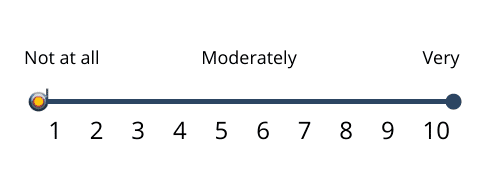
Hunger Vs. Craving
Another important skill is the ability to differentiate between hunger and cravings. Hunger is a physiological response with objective indicators. Building an understanding of your own unique triggers and true ques can help you to master your own self-observation. For example, hunger’s physical symptoms are different for everyone and may include fatigue/weakness, irritability (hangry), rumbling tummy. It usually isn’t an instant feeling but rather arises gradually. Whereas cravings tend to arrive more instantly with an emotional response often accompanied by feelings of loss of control.
While mindfulness might seem like a trait that someone just has, rather it is more a skill that can be developed with motivation to enhance self regulation through a belief in the value of mindfulness and a person’s own ability to develop the skill.
It requires attention, reflection & practice.
The more sharepend the skill, the more power we have to make decisions in line with our values and goals, regardless of our external environment.
have a look at our Mindful Kitchen article for an insight into a mindful approach to your cooking that can help you unwind and improve your relationship with food and cooking.
References
Bishop, S.R., Lau, M., Shapiro, S., Carlson, L., Anderson, N.D., Carmody, J., Segal, Z.V., Abbey, S., Speca, M., Velting, D. and Devins, G., 2004. Mindfulness: A proposed operational definition. Clinical psychology: Science and practice, 11(3), p.230.
Nelson, J.B., 2017. Mindful eating: The art of presence while you eat. Diabetes Spectrum, 30(3), pp.171-174.
Price, C.J. and Hooven, C., 2018. Interoceptive awareness skills for emotion regulation: Theory and approach of mindful awareness in body-oriented therapy (MABT). Frontiers in psychology, 9, p.798.


